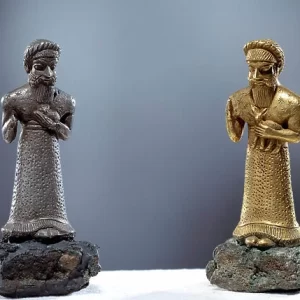Lindholm Hoje is an ancient graveyard of the Vikings that had been lost for one thousand years, buried beneath thousands of tons of sand. As many as 700 burials, along with the remains of settlements from the Viking Age and the preceding Germanic Iron Age have been found at this important archaeological site in Denmark.
During the Cretaceous period, chalk formations were created along the Limfjord in Denmark. These formations, which are in the form of hills, stretch from Aalborg to the east. One of these hills is Lindholm Høje, which is situated on the northern side of the Limfjord, opposite the modern city of Aalborg. One reason that made this area an attractive place to establish a settlement is that this is where the Limfjord is at its narrowest, which made it an important crossing between the North Jutlandic Island and the Danish mainland. Apart from that, Lindholm Høje occupied a strategic defensive position. Rising to 42 m (137 ft.) above sea level, anyone living on the hill could command an excellent view over the fjord. This meant that if an enemy was approaching the hill, they would be easily detected. Thirdly, the soil on the hill is said to be drier than the surrounding area, which made cultivation easier.

Lindholm Høje was already settled around 400 AD. This is supported by the graves that were found at the site, the oldest of which have been dated to this point of time. These graves can be found on the top of the hill, and as one progresses down Lindholm Høje, the graves in turn become younger. The oldest graves are said to contain inhumation. This burial practice, however, is found to have changed not long after to cremation. Thus, the majority of graves (apart from the oldest ones) found at Lindholm Høje have been found to contain cremated human remains.
As for the remains of settlements, it has been reported that the remains of two villages have so far been excavated, one situated to the north, and another to the south. The former is said to have been dated to 700 – 900 AD, whilst the latter to 1000 – 1150 AD. The northern village is said to consist of several houses, fences, five wells and a road. It has also been estimated that there were six families inhabiting this village, each of which consisting of between 10 and 15 family members. There were also smaller buildings for work purposes, and it has been suggested that spinning and weaving were carried out in such structures. Similar buildings were found in the southern village. This was the last settlement on Lindholm Høje.

One factor that may have resulted in the abandonment of the site as a place for human habitation is the phenomenon of sand drift. It has been stated that at the beginning of the Viking Age, most of Denmark was covered in forests. Over time, however, the trees were chopped down to make various things, such as houses, ships and roads. As a result of this deforestation, the land in the western part of Jutland became exposed to the rough westerly winds. This continuous exposure led to degradation in the quality of the soil, perhaps due to erosion. Additionally, large amounts of sand were carried by the winds, and covered the land.When archaeologists began excavating in the 1950s, they found that Lindholm Høje was covered by a layer of sand that was several meters thick. The lack of suitable land for cultivation may have led the inhabitants of Lindholm Høje to migrate to somewhere else. On the other hand, the sand helped to preserve the burial sites, as well as the stone circles that marked the graves.

Urnes style brooch in bronze; a silver version was found at Lindholm Høje.
Today, Lindholm Høje is a tourist destination for those who would like to know more about the site’s history. Apart from the site itself, there is also a museum, where artifacts recovered from excavations, as well as reconstructions of various aspects of Lindholm Høje may be found.





